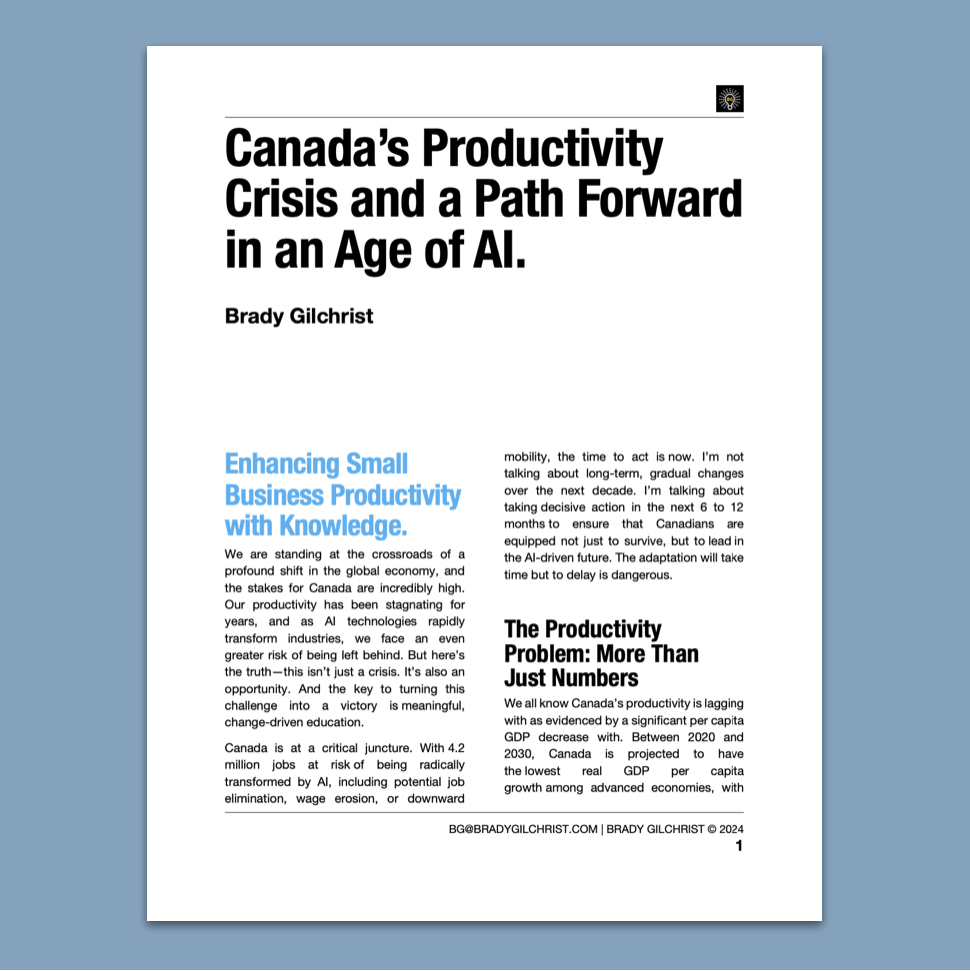Enhancing Small Business Productivity with Knowledge.
We are standing at the crossroads of a profound shift in the global economy, and the stakes for Canada are incredibly high. Our productivity has been stagnating for years, and as AI technologies rapidly transform industries, we face an even greater risk of being left behind. But here’s the truth—this isn’t just a crisis. It’s also an opportunity. And the key to turning this challenge into a victory is meaningful, change-driven education.
Canada is at a critical juncture. With 4.2 million jobs at risk of being radically transformed by AI, including potential job elimination, wage erosion, or downward mobility, the time to act is now. I’m not talking about long-term, gradual changes over the next decade. I’m talking about taking decisive action in the next 6 to 12 months to ensure that Canadians are equipped not just to survive, but to lead in the AI-driven future. The adaptation will take time but to delay is dangerous.
The Productivity Problem: More Than Just Numbers
We all know Canada’s productivity is lagging, as evidenced by the slow growth in per capita GDP. Between 2020 and 2030, Canada is projected to have the lowest real GDP per capita growth among advanced economies, with only a 0.7% annual increase, placing it at the bottom of the rankings. This trend is expected to continue through 2060[1], with low productivity growth being the main driver behind this poor performance. The goods-producing sectors, including construction and manufacturing, are especially inefficient, dragging down the entire economy. This recent TD Economics report[2] confirms what many of us already feared: we’re moving from bad to worse. AI could be the solution—offering the potential to drive innovation, and allow workers to focus on high-value, creative activities.
But here’s the problem: we’re not ready. Our education system, while strong in many ways, is too slow and too rigid to adapt to this seismic shift. The current model, focused on long-term degree programs, formal credentials and even the emerging micro-credentials approach are mired in legacy bureaucracy. The existing system won’t cut it in an environment where the workforce needs rapid, job-ready skills. We need to begin the process of retraining millions of workers in months, not years.
[1] Williams, David. Canada’s Productivity Performance Over the Past 20 Years. Business Council of British Columbia, May 24, 2022. Available at: https://www.bcbc.com.
Williams, David. OECD Predicts Canada Will Be the Worst Performing Advanced Economy Over the Next Decade…and the Three Decades After That. Business Council of British Columbia, December 14, 2022. Available at: https://www.bcbc.com.
[2] Caranci, Beata, and James Marple. From Bad to Worse: Canada’s Productivity Slowdown is Everyone’s Problem. TD Economics, September 12, 2024.
AI Is Here: Are We Ready?
Let’s be clear: AI isn’t coming. It’s already here. And it’s transforming jobs faster than we can retrain people to fill new roles. Canada has a workforce where 31% of jobs according to StatsCan are highly exposed[1] to AI-related disruptions, and many of these are in sectors like customer service, clerical work, and administration. Without immediate action, we risk massive job losses and the erosion of wages in jobs that once provided stability.
But AI isn’t just about job losses. It’s about transformation. AI can be a powerful tool for productivity and innovation—but only if workers are trained and learn to harness its potential. We need to teach Canadians how to partner with AI, how to use it to augment their roles, and how to thrive in a world where technology is integrated into everything we do.
[1] Mehdi, Tahsin, and René Morissette. Experimental Estimates of Potential Artificial Intelligence Occupational Exposure in Canada. Analytical Studies Branch Research Paper Series. Statistics Canada, September 3, 2024. Catalogue no. 11F0019M, no. 478.
AI Is Here: Are We Ready?
The key to Canada’s future lies in education. Not the kind of education that takes four years to complete, but rapid, meaningful learning experiences that equip workers with the skills they need to thrive in the AI economy. We need to develop short-term programs that focus on AI-specific skills, like automation, data analysis, and decision-making, while also emphasizing creativity, critical thinking, and problem-solving—the skills that machines cannot replicate.
Canada’s post-secondary system, while valuable, simply isn’t built for this kind of transformation. It’s time for the private sector to step up. Private companies are uniquely positioned to offer fast, flexible training that can be scaled quickly. AI-powered education platforms, micro-credential programs, and boot camps and playbooks can provide workers with job-ready skills in a matter of months. The private sector isn’t just a faster alternative—it’s also more closely aligned with the needs of the job market. As entrepreneurs and business leaders, we can create practical solutions that meet the demands of the AI economy. We can create work-integrated learning opportunities and industry-specific training that ensures workers are prepared to take on new, AI-enhanced roles
Time Is of the Essence: The Next 12 Months Are Critical
Without immediate action, Canada risks falling behind in the global race for AI dominance. Our businesses will struggle to compete, our workers will be left without the skills they need, and our economy will continue to stagnate. But if we act now, if we embrace this challenge with vision and urgency, we can lead the world in AI-driven productivity and innovation.
This is not the time for incremental changes or bureaucratic delays. We need to rethink how we approach education for workforce development. We need short-term retraining programs that offer practical, job-ready skills in AI. We need to empower Canadians to take control of their careers and partner with AI, rather than be displaced by it.
We can turn this moment of crisis into a moment of opportunity. By embracing meaningful, rapid education, we can enhance our productivity, mitigate the risks posed by AI, and transform those risks into an opportunity for growth and leadership.

…

